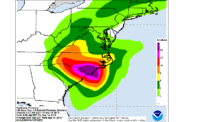Exhibiting a tropical storm's propensity for unpredictability, Hurricane Florence is expected to slow as it nears the coast of North Carolina on Sept. 13. Still a Category 3 storm with maximum sustained winds of 125 mph, Florence is projected to linger offshore the next day before making landfall around the North and South Carolina border early Saturday morning.
 |
The prospect of days of pounding waves increase the probability of overwash and erosion along barrier islands, as well as coastal storm surge pressing inland and up estuaries beyond the coastline. The National Weather Service's Tropical Analysis and Forecast Branch reported open ocean wave heights as high as 83 ft in Florence's northeast quadrant. According to the agency, these waves are produced by being trapped along with very strong winds moving in the same direction as Florence's westward track.
Areas of southeast North Carolina could see 20 in. or more of rainfall, while inland South Carolina is currently forecast to receive 6 to 15 in. The expected deluge has renewed concerns about the safety of the state's public and privately owned dams, several dozen of which failed during a 1,000-year rain event in 2015.
South Carolina Dept. of Health and Environmental Control (DHEC) spokesperson Tommy Crosby says the agency is prioritizing the assessment of dams located in areas predicted to receive large amounts of rain. As of Sept. 11, the agency had assessed 181 dams "to help dam owners ensure their dams are set in the safest condition possible." Crosby says. The dam assessments are prioritized according to various criteria, such as being in the evacuation zone or along the evacuation routes. Dams that are under repair or have a known history of problems are also given high priority.
DHEC has also implemented an alert system to notify more than 2,000 dam owners of the need to evaluate their water levels and coordinate lowering levels with other owners downstream to avoid flooding.
With Florence expected to weaken to a tropical depression over extreme western South Carolina by Sept. 17, Georgia's Environmental Protection Division is coordinating with other state dam programs in the southeast. State dam-safety experts are also ready to respond as needed, according to an agency spokesperson.
Road Construction Halted
Also in Georgia, the Dept. of Transportation has suspended road construction on its major eastern interstates—I-20, I-16 and I-95—to ensure capacity for evacuations and response efforts.
The U.S. Army Corps of Engineers says it has received 13 mission assignments for Hurricane Florence, including debris management and infrastructure, and water and wastewater facility assessments.
Hurricane preparations are a familiar story for a Robins & Morton project team building an 11-story, 625,000-sq-ft hospital for the Medical University of South Carolina in Charleston. In 2016, despite the team's best efforts, Hurricane Matthew completely flooded the jobsite along with the rest of the facility.
With the facility now nearing completion, the project team has taken pre-storm steps, such as moving unsecured equipment into core sections of the building, lowering the tower crane and boarding up structural openings. A webcam will help Robins & Morton monitor the building's condition as Florence moves across the region.



